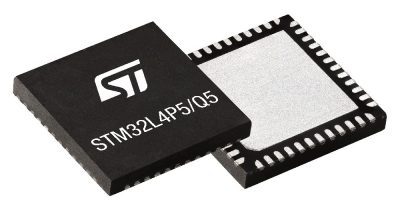Two microcontrollers from STMicroelectronics, the STM32L4P5 and STM32L4Q5 microcontrollers bring the performance of the Arm Cortex-M4 core to cost-sensitive and power-conscious smart connected devices, says the company. Target applications include utility meters, industrial and medical sensors, fitness trackers, and smart home products.
The STM32L4+ microcontrollers have memory density down to 512kbyte flash and 320kbyte SRAM. They are available in a choice of package options: 10 x 10mm, 64-pin and 7.0 x 7.0mm, 48-pin versions designed to meet applications limited by size constraints such as wearable form factors.
They have independent power connections for circuitry such as USB and analogue peripherals, independent clock domains, and octal and quad serial peripheral interfaces (SPIs) for external memory expansion. They also feature a 5Msample/s smart ADC that can operate at full speed to minimise acquisition time, or at reduced speed with lower current.
The STM32L4+ microcontrollers exploit ST’s low-power microcontroller technologies and feature seven main low-power modes, enabling designers to creatively manage power consumption and wake-up times to minimise energy demand. The microcontrollers also support FlexPowerControl, which ensures energy-efficient handling of processing loads, as well as batch acquisition mode for energy-efficient data capture while the CPU is stopped.
To preserve system reliability and safety in industrial and medical applications, the STM32L4+ microcontrollers have flash error-correcting code (ECC) support and hardware parity checking for SRAM.
Cyber-protection features include a true random number generator and IP protection through limited access to code stored in internal memory. STM32L4Q5 devices feature additional cryptographic accelerators that support AES, RSA, DH and ECC acceleration.
The STM32 development ecosystem now includes the Nucleo-L4P5ZG Nucleo-144 board and STM32L4P5G-DK Discovery kit, each containing an STM32L4P5 microcontroller.
In the STM32Cube ecosystem, the STM32L4P5 and STM32L4Q5 are supported by the STM32CubeL4 microcontroller package, which contains hardware abstraction layer and low-layer (HAL/LL) peripheral drivers, middleware components and examples projects, and by the STM32CubeMX initialisation-code generator and configurator, which has a power consumption calculator.
ST reports EEMBC benchmark scores of 409 CoreMark and 285 ULPMark-CP for performance and energy efficiency.
Samples are available immediately and full production is ramping up, says ST.







